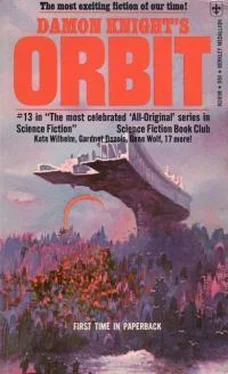Дэймон Найт - Orbit 13
Здесь есть возможность читать онлайн «Дэймон Найт - Orbit 13» весь текст электронной книги совершенно бесплатно (целиком полную версию без сокращений). В некоторых случаях можно слушать аудио, скачать через торрент в формате fb2 и присутствует краткое содержание. Год выпуска: 1974, ISBN: 1974, Издательство: Berkley Medallion, Жанр: Фантастика и фэнтези, на английском языке. Описание произведения, (предисловие) а так же отзывы посетителей доступны на портале библиотеки ЛибКат.
- Название:Orbit 13
- Автор:
- Издательство:Berkley Medallion
- Жанр:
- Год:1974
- ISBN:0425026981
- Рейтинг книги:5 / 5. Голосов: 1
-
Избранное:Добавить в избранное
- Отзывы:
-
Ваша оценка:
- 100
- 1
- 2
- 3
- 4
- 5
Orbit 13: краткое содержание, описание и аннотация
Предлагаем к чтению аннотацию, описание, краткое содержание или предисловие (зависит от того, что написал сам автор книги «Orbit 13»). Если вы не нашли необходимую информацию о книге — напишите в комментариях, мы постараемся отыскать её.
Orbit 13 — читать онлайн бесплатно полную книгу (весь текст) целиком
Ниже представлен текст книги, разбитый по страницам. Система сохранения места последней прочитанной страницы, позволяет с удобством читать онлайн бесплатно книгу «Orbit 13», без необходимости каждый раз заново искать на чём Вы остановились. Поставьте закладку, и сможете в любой момент перейти на страницу, на которой закончили чтение.
Интервал:
Закладка:
Passing by Millie Perkins’ house, I see her in her usual place in the bay window, where she can see the street, see the TV set, and reach the telephone at the same time. She is at the phone now. No doubt she is anxious to discuss the soap opera which has just finished its latest episode, the afterimage of the final frame still etched on the screen, the final organ groan vibrating the china as she dials. The TV provides more of her gossip than the street does these days. She is probably calling my wife, herself an intimate of the mythical personalities that dance and blink through our living room:
(“Yes, you did get a call last night, just before you got home, but it came during the last five minutes of Gunsmoke, and then Millie was on the phone, and I forgot to tell you.” “What did the caller say?” “He said there was an unconscious, woman in a car on the road to Walshville. Oh, dear, I do hope nothing terrible happened to her.”)
I may examine one or two more kids, but probably not. We will decide there is little point in it.
“What is it, Dr. Tyler?” Mrs. Dreiser will say. “What’s wrong with them? It doesn’t make any sense, and I, for one, am scared.”
“I don’t know,” I will say. “Can’t understand it myself. I’ve seen people like this many times in my career. It’s often a reaction to mourning, or a buried psychological problem. Usually the person will come out of it by himself, given time. I’ve never seen it so lasting or widespread, though. If it’s any consolation to you, it’s happening all over the country, striking the young mostly, just like here. It started in the small towns, but it’s spreading to the cities now.”
“But what is it?” Sam will say.
“The journals have called it various things. I prefer ‘chronic apathy’ myself. It’s as good a term as any. I haven’t heard any satisfactory explanation of the cause.”
Mrs. Dreiser will probably start sobbing. “What’s going to become of these young people?” she will ask between sniffles.
“Yes, Dr. Tyler,” Sam will say. “What are we to do? What are we to do?”
I will hide my face and shake my head, and pretend I don’t feel like crying myself. I will pretend there never was a time when I was ready for any commitment, no matter how great; never a time when my hope and confidence and energy were unlimited.
“I wish I knew, Sam,” I will say. “I wish I knew.”
Steve Herbst
CREATION OF A FUTURE WORLD IN THE TRACER
FROM MEDIA, December, 1931: Of all the movies’ dream worlds, the palaces and exotic places in which we seek an escape from our Depression-burdened lives, by far the most fascinating and full of hope, is the dream world of the future. Indeed, the opulence of a screen drama is real for the actors alone, but the future belongs to everybody. And yet only a few films have tried seriously to deal with the consequences of scientific advancement and the changes that will result in art and society. “Science fiction” in the American cinema has lacked realism and has depended as much upon the imagination of the viewer as upon that of the filmmaker. In early September, however, German-born director Francis Rehage released The Tracer, a thrillingly realistic portrayal of the future. Rehage has made seven films in this country in three years; 1929’s Automobile and his commissioned work regarding the upcoming World’s Fair both demonstrate an uncanny talent for fooling his audience with special film effects. In The Tracer, he has developed this talent to a remarkable level. Although the film is limited in scope, it affords us a most breathtaking view of a world that exists in Rehage’s mind.
Its simple story involves a robbery, the pursuit, and the eventual destruction of the criminal. Rehage’s protagonist criminal, played by burly Arnold Cooke and whose name in the film we never discover, is very much like the misanthropic heroes of Public Enemy and Big House. He is essentially fearless, possessed with the overpowering need to be on top. But despite his tough character, he is over his head in a technological super-world. Here, perhaps, is the film’s single most disturbing flaw: Cooke lives in that world but does not really belong to it; he is surprised and baffled, as we are, by elements of the future that he should take for granted. There is in him a fatal and enigmatic lack, because of which he is hopelessly at odds with the environment in which he finds himself. From the moment the film opens he faces justice in the form of mechanical devices, unlike anything that exists today and yet frighteningly convincing. No alarm sounds when he enters the offices of the futuristic Olympian Industries, but in an opening scene we follow his actions on a pair of eerie television-like screens. Here is where Rehage’s construction of a technology begins. To give the effect of impossibly sharp television pictures on the faces of impossibly small machines, Rehage used multiple exposure to combine three separate shots on one piece of film. The television pictures are actually film images printed through a grid of horizontal lines onto high contrast film. When they are added to the background of desk and office, it appears that we are witnessing the first in a series of electrical marvels.
The office scenes also show a whole range of more mundane objects that were completely redesigned for the future. Telephone switchboard, telephones and typewriters are all streamlined and highly polished, dotted with trademarks and switches to make them seem real. Light fixtures and furniture were created especially for The Tracer out of what architects have said are the materials of the future: chromed steel, hardwoods, and white opaque glass. Wall-to-wall carpeting covers all the floors. The effect produced is glamorous, the appliances expensive yet functional. Director Rehage had a large staff of designers to help him, but it is the coordination of their efforts and the unity of their styles that creates the illusion of a future world for us. Rehage’s approach was to eliminate the frills of our modernistic art while preserving the simplicity of straight lines and smooth surfaces. The same philosophy of styling was applied to every object in his sets: the frames of doors, the elevator with its pushbutton controls, the squared man-sized forms that appear to be coin-operated vending machines. Such extensive and precise work must require a great deal of money; even though many of the design problems were handled by private companies. Rehage spent over a hundred thousand dollars building the office sets alone.
His outstanding achievement in these early scenes is the awesome dusk skyline of Chicago that we see for a total of under two minutes, behind the desk of Eric Haller. It is so believable and unusual, in fact, that we may tend to ignore Haller himself, the first man that Cooke encounters during the film. We should say a few words about this set. It was constructed primarily out of plywood and extends fifty feet behind the window of Haller’s office, and was used only in this final office sequence. A small staff spent two weeks building it, to Rehage’s detailed specifications; it is in almost no way related to the city’s present appearance. When time came for filming, Rehage sealed off the portion of the studio that contained his model and filled it with smoke. The haze hanging over the city keeps us from making out any detail that might give it away. This effective illusion, sealed off by a window from the clean and brightly lit office interior, takes us once and for all into the future.
Simon Stern plays Haller, the business official who has been patiently watching Cooke on his television screens. Stem’s portrayal of the character is as otherworldly as his surroundings. He never gets up from his chair behind the long hardwood desk, and he is perfectly calm in Cooke’s presence. When the burglar pulls a gun on him, he only smiles. Clearly he is so far above the visitor in rank, in resources, and in subtlety that he is beyond fear. But in a way it seems that Haller hardly sees the other man, almost as if there is a barrier between them that makes it ultimately impossible for him to believe that Cooke exists. Meanwhile, the future which is on his side, the lofty panorama of the city behind him, arouse an overwhelming jealousy and hatred in his opponent. Before Haller can react, Cooke has shot him with his gun. Surprise and disbelief cross his face; now we see for the first time an almost featureless white box that Haller breathily refers to as “the tracer.” Haller’s blood stains his tan suit; he watches as Cooke makes off with the box.
Читать дальшеИнтервал:
Закладка:
Похожие книги на «Orbit 13»
Представляем Вашему вниманию похожие книги на «Orbit 13» списком для выбора. Мы отобрали схожую по названию и смыслу литературу в надежде предоставить читателям больше вариантов отыскать новые, интересные, ещё непрочитанные произведения.
Обсуждение, отзывы о книге «Orbit 13» и просто собственные мнения читателей. Оставьте ваши комментарии, напишите, что Вы думаете о произведении, его смысле или главных героях. Укажите что конкретно понравилось, а что нет, и почему Вы так считаете.


